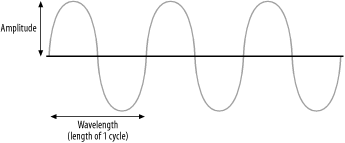1.1 Radio Waves
| < Day Day Up > |
| Radio waves are created when electrically charged particles accelerate with a frequency that lies in the radio frequency (RF) portion of the electromagnetic spectrum. Other emissions that fall outside of the RF spectrum include X-rays, gamma rays, and infrared and ultraviolet light. When a radio wave passes a copper wire or another electrically sensitive device, it produces a moving electric charge, or voltage, which can be transformed into an audio or data signal. Radio waves can be depicted mathematically as a sinusoidal curve, as shown in Figure 1-1. Figure 1-1. A sine wave representing a radio wave The distance covered by a complete sine wave (a cycle) is known as the wavelength . The height of the wave is called the amplitude . The number of cycles made in a second is known as the frequency . Frequency is measured in Hertz (Hz), also known as cycles per second. So, a 1 Hz signal makes a full cycle once per second. You should be familiar with this unit of measurement: if your new computer's CPU operates at 2 GHz, the internal clock of your CPU generates signals roughly at two billion cycles per second.
1.1.1 Radio Frequency SpectrumTo regulate the use of the various radio frequencies, the Federal Communications Commission (FCC) in the United States determines the allocation of frequencies for various uses. Table 1-1 shows some of the bands defined by the FCC (see http://www.fcc.gov/oet/spectrum/table/fcctable.pdf). Table 1-1. Range of frequencies defined for the various bands
You can get a more detailed frequency allocation chart from http://www.ntia.doc.gov/osmhome/allochrt.pdf. The following conversion list should help you understand this chart:
Wireless networks use a variety of radio frequencies. Table 1-2 shows some common wireless network protocols and the corresponding radio frequencies. Table 1-2. Frequencies used by various wireless networks
1.1.2 Radio Wave BehaviorRadio waves, similar to light waves, exhibit certain characteristics when coming into contact with objects. Reflection occurs when a radio wave hits an object that is larger than the wavelength of the radio wave (see Figure 1-2). The radio wave is then reflected off the surface. Figure 1-2. Reflection of a radio wave Refraction occurs when a radio wave hits an object of a higher density than its current medium (see Figure 1-3). The radio wave now travels at a different angle ”for example, waves propagating through clouds. Figure 1-3. Refraction of a radio wave Scattering occurs when a radio wave hits an object of irregular shape, usually an object with a rough surface area (see Figure 1-4), and the radio wave bounces off in multiple directions. Figure 1-4. Scattering of a radio wave Absorption occurs when a radio wave hits an object but is not reflected, refracted, or scattered . Rather, the radio wave is absorbed by the object and is then lost (see Figure 1-5). Figure 1-5. Absorption of a radio wave
Diffraction occurs when objects block a radio wave's path . In this case, the radio wave breaks up and bends around the corners of the object (see Figure 1-6). This property allows radio waves to operate without a visual line of sight. Figure 1-6. Diffraction of radio waves |
| < Day Day Up > |
EAN: 2147483647
Pages: 100
